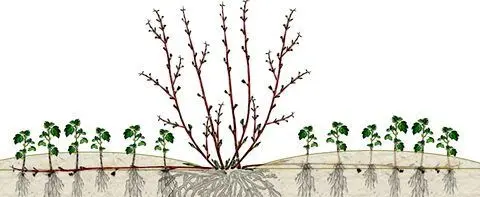Contents
Currant Delicacy is a modern variety bred by domestic breeders and able to withstand difficult climatic conditions. It is frost-resistant, high-yielding, undemanding in cultivation and care, resistant to pests. The berries of this variety of blackcurrant are fragrant, tasty, large.
Description of the blackcurrant variety Delicacy
Delicacy is a blackcurrant variety of medium-early ripening of selection. It was bred at the Pavlovsk experimental station in the Leningrad region by Volodina E.V., Khotimskaya S.P., Tikhonova O.A. in early 2000, who used blackcurrant varieties Odzhebin and Minai Shmyrev in breeding work. In 2007, the Delicacy variety was included in the State Register of the Federation of varieties that are allowed for cultivation in the Central Region, the Far East, the Northern and North-Western regions.
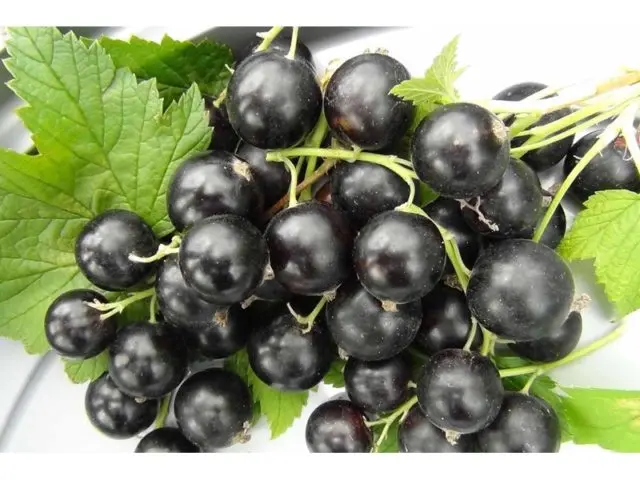
The description of the main characteristics of the blackcurrant of the Delicacy variety helps to evaluate the varietal characteristics.
Bush
The currant shrub of this variety is medium spreading, tall (1,5 m) with a dense crown. Young shoots are even, green in color with a smooth shiny surface, thick, slightly drooping. The color of the lower part is uneven, of a weak anthocyanin shade.
Mature lignified brown-brown branches slightly run down in thickness to the top. They are shiny, slightly lowered, cranked. In general, the bush is massive, withstands gusty winds and does not need to be tied up.
The buds on the Delicacy currant bush are solitary, medium-sized, oval in shape with a pointed top. They are rejected, lowered, painted in pinkish or lilac color. The apical kidney is large, ovoid.
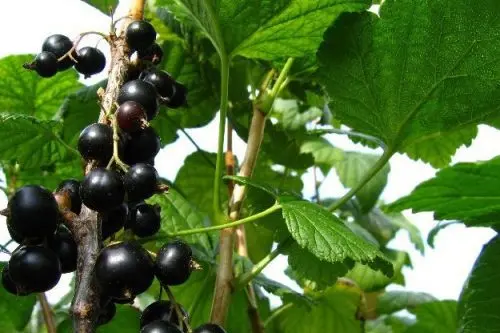
Leaves
Blackcurrant leaves Delicacy are five-lobed, medium and large in size. They are shiny and dark green in color. The surface of the leaf is leathery, wrinkled. On the upper and lower sides of the leaf blade, the main veins are sparsely omitted. The leaf is concave along the central vein. The main veins in most cases are not colored. On some leaves from the base to the midrib there is a slight anthocyanin coloration.
The central lobe of the leaf is large, concave, ovoid, pointed. Additional protrusions are hardly noticeable. Lateral lobes – shorter than average. They are oval in shape with tops oriented to the sides. Basal lobes weakly expressed, with open veins.
The base of the leaf is heart-shaped, with a deep or medium-sized depression. A typical feature of the Delicacy currant variety is the funnel-shaped concavity of the middle lobe of the apical leaves. This impression is created by the raised edges of the lateral and basal lobes.
The leaf teeth have clear, short, shallow “claws”. The petioles of the leaves are located at an angle of almost 60 degrees to the branch. They are thick, medium in length, green in color. Their shape is straight or slightly curved
Flowers
The flowers of the blackcurrant shrub of the Delicacy variety are medium-sized, pinkish in color, goblet-shaped. The petals are oval with a slight anthocyanin color, slightly inclined towards the pistil and touching each other. The stigma of the pistil is located above the anther.
Ovary uncolored, smooth, uncovered. The brushes can be 4,5 – 6,8 cm long and contain 5 – 8 berries. The axis of the brush is not thick, green in color with a short or medium petiole. The stalks of the berries are long, drooping, green and medium in thickness.
Berries
Delicacy currant berries are classified as medium-large. Their weight is 0,9 – 1 g, size – up to 1 cm in diameter. They are black light, round or slightly oval, with a shiny surface. Inside the berries there are about 50 small seeds that are practically not felt in taste. The calyx is small, some berries may be wide. It is falling or semi-falling.
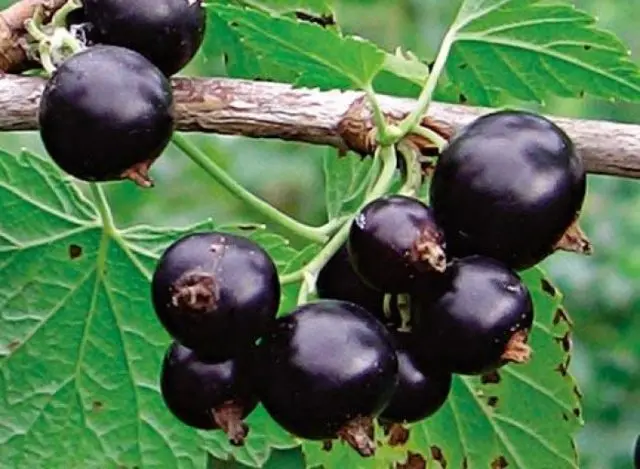
Currant taste is delicate, sweet and sour, fragrant, tasting score is 4,9. The skin of the berries is thin and soft, but, at the same time, dense. Their flesh is juicy.
The chemical composition of fruits is shown in the table:
Substance | Average content, % |
Water | 83 |
Fibre | 4,8 |
Carbohydrates | 7,3 |
Proteins | 1 |
Fats | 0,4 |
Features
The blackcurrant variety Delicacy is classified as early-growing, with medium self-fertility. Cultures of this variety are characterized by endurance to low temperatures. It is resistant to diseases and pests characteristic of blackcurrant:
- leaf spot;
- powdery mildew;
- bud mite (medium resistance).
The description of the features of the Delicacy currant variety is confirmed by the reviews of experienced and novice currant growers.
Drought resistance, frost resistance
Currant Delicacy – a variety with excellent frost resistance. Plants tolerate temperatures down to -20 °C well without shelter. When the bush is insulated for the winter, it does not freeze in frost down to -35 ° C, making the variety suitable for growing not only in the central regions, but also in the harsh conditions of Siberia and the Urals. The culture is not susceptible to return spring frosts.
The drought resistance of the variety is low. The shrub needs good watering, but excess moisture is undesirable.
Productivity of the variety
Variety Delicacy is classified as early ripening, with high yields. The indicators that characterize it are described in the table:
Index | Value |
Yield per bush | up to 12 kg |
Average berry yield | up to 196 c/ha |
Age of onset of fruiting | 2 years |
Fruiting period: formation of berries · singing |
· early July; mid-July – early August. |
Berries of the Delicacy variety are harvested when they turn a bright black color. Properties of ripe currant:
- fruits are easily separated from the bush;
- thanks to the dense skin, the berries are not crushed during transportation and retain their juiciness;
- as the fruit ripens, the size of the fruit does not decrease;
- currants are not prone to shedding;
- berries do not bake in the sun.
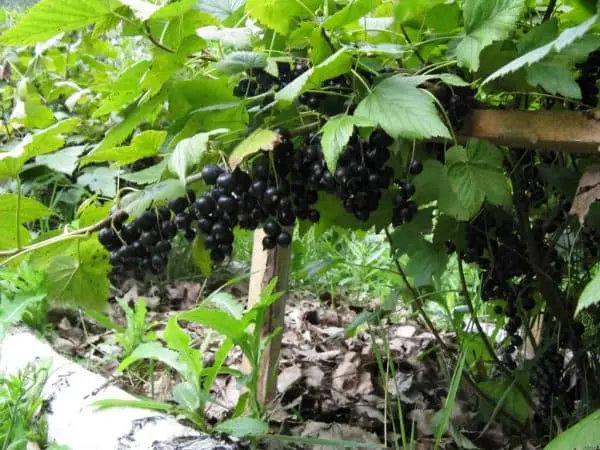
Application area
Blackcurrant of the Delicacy variety is popular in household plots and farms. It is used to make jams, preserves, juices, compotes, jelly, smoothies, and is added to the filling of pies. Based on the berries, wines, liquors and tinctures are prepared. Currants can be consumed raw and canned.
Berries of this variety can be dried and also frozen. After defrosting, their shape and taste are not lost. The crop is well stored and suitable for transportation.
Pros and cons of the variety
Blackcurrant Delicacy has advantages and disadvantages. Variety benefits:
- High palatability of berries.
- Ripening in mid-early time.
- Abundant fruiting.
- Frost resistance.
- Resistance to diseases characteristic of blackcurrant.
- fruit transportability.
- Ease of cultivation and care.
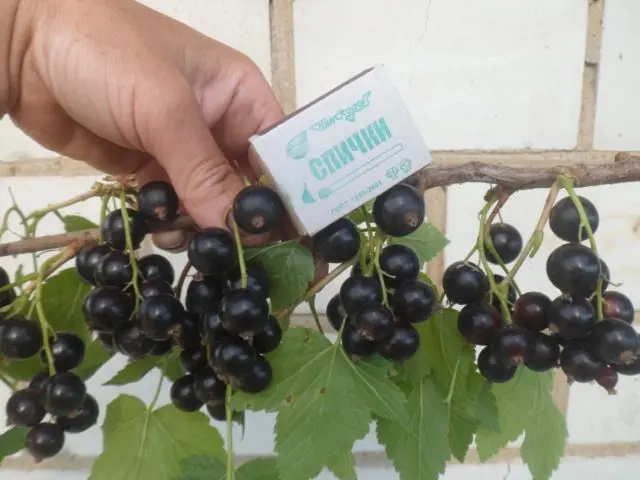
The variety has a drawback – low self-fertility, that is, the ability to be pollinated by its own pollen. Blackcurrant Delicacy gives high and stable yields in the presence of pollinating varieties. Nearby you can plant shrubs of self-fertile varieties, for example, Golubka, Pobeda or September Daniel.
Methods of reproduction
Blackcurrant of the Delicacy variety is propagated in the following ways:
- Cutting. In autumn, in October, a healthy shoot 15–20 cm long is separated from a blackcurrant bush and cut into pieces with a pruner. On each segment there should be 2 – 3 places with sleeping kidneys. If there are leaves, they are broken off. Then the cuttings are transplanted into the prepared soil at an angle of 60 degrees. Usually they take root well and immediately begin to grow.Important! Cuttings of currants can be carried out in the spring, but with insufficient watering, the segments may not have time to grow developed roots and dry out.

- Layers. This is an effective way to propagate Delicacy currants, because the cuttings take root and take root well. The procedure is carried out in autumn or early spring. Healthy strong annual shoots growing from the outside of the bush are placed in small trenches, 5 cm deep and fixed with hairpins. Layers are watered abundantly. The resulting shoots spud, and in the fall they are separated from the mother bush and transplanted to a permanent place.

- By dividing the bush. This is a simple method that is used when replanting or rejuvenating a currant bush. A healthy maternal copy of the Delicacy currant is spudded in early spring. In summer, the earth is sprinkled twice. Constantly keep the soil moist, avoiding its drying out. In September, the bush is dug up and divided into parts. Delenki are immediately planted in a permanent place.

Planting and care
A suitable time for planting Delicacy blackcurrant is late autumn or early spring, after the snow has melted. For this purpose, planting material is selected that meets the requirements:
- on the seedling there should be 3 – 5 healthy shoots;
- the root system is developed, healthy, the roots are light.
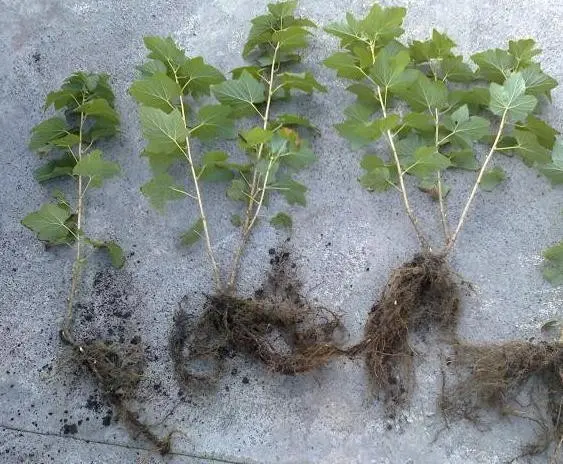
A place for blackcurrant Delicacy is chosen well-lit, but slight shading is allowed. They begin to prepare it for planting in a few years, removing germinating weeds, periodically digging and fertilizing (humus or rotted manure). The earth is preferably light, loose, fertile, with low acidity. These requirements are met by weakly podzolized, loamy and sandy soils. If groundwater runs close, then in order to avoid stagnation of moisture at the roots, the bush is planted on a hill or drainage is organized.
Algorithm for planting currant varieties Delicacy:
- At the chosen place, holes are dug for seedlings 40-60 cm wide, 30-40 cm deep, with an interval of 1,5-2 m from each other. Rows are also organized at a distance of 1,5 – 2m.Important! To feed the currant shrub of the Delicacy variety, an area with a radius of about 2 m is required.
- Phosphate and potassium fertilizers are applied to the bottom of the hole mixed with humus in the following proportion: superphosphate – 50 g, potassium sulfate – 20 g, humus – 5 – 6 kg. Then pour half a bucket of water.
- The seedling is placed in the hole at an inclination of 45 degrees, its roots are sprinkled with earth and rammed.
- The planted plant is watered with ½ bucket of water.
- The trunk circle of the bush is mulched with humus, peat or rotted manure.
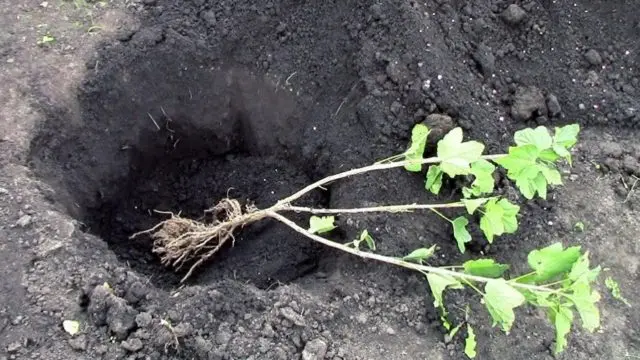
Aftercare
To ensure high yields and preserve varietal characteristics, Currant Delicacy needs proper care:
- Blackcurrants are often watered under the root, in dry and hot weather – every other day. The lack of moisture adversely affects the development of the plant. Watering is stopped during the period of ripening berries. The optimal amount of water for irrigation is a bucket per bush, twice a day, in the evening and in the morning.
- Feed once a month (urea, superphosphate, potash fertilizers). The nutrient mixture is diluted in water, according to the instructions, and the currants are watered.
- Currant shrubs of the Delicacy variety need regular pruning. In early spring, before bud break, or in late autumn, after leaf fall, a shaping and rejuvenating haircut is carried out. For sanitary purposes, the bush is pruned during the entire growing season. At the same time, shoots older than 5 years, diseased and twisted branches, shoots growing near the ground are removed.Attention! A well-formed delicacy currant bush has approximately 15 branches of different ages: 3 are annual shoots, 3 are biennial, and so on.
- To prevent damage to the bark of seedlings by rodents, the accumulation of household waste and plant residues on the site should not be allowed. In winter, after a snowfall, the snow is trampled down around the bushes. In a dense layer, it is difficult for mice to move and make moves. Hares usually do not touch currants.
- Currant bush of the Delicacy variety is powerful, stable and does not need a garter.
- When growing the Delicacy variety in the southern and central regions, special preparation of shrubs for winter is not required. In late autumn, fallen leaves are removed, the soil of the near-trunk circle is shed and dug up. The soil surface at the root collar is mulched.
- Currant branches grown in regions with a cold climate are tied in bunches, bent to the ground and strengthened in this position. The fallen snow bush will cover and protect from frost. The shrub can not be lowered, but covered with agrofiber.

Pests and diseases
Despite the resistance of blackcurrant Delicacy to powdery mildew, spotting and bud mites, it is necessary to constantly monitor the condition of the branches and leaves of the plant. If signs of disease or pests appear on the shoots, they should be removed immediately. This is done to prevent the spread of infection to other organs of the shrub. The soil around the currant is treated with antibacterial drugs or folk remedies, for example, an infusion of garlic or onions. From currant aphids, glass cases, bud mites, sawflies, gall aphids, plants are sprayed with Phytoferm, Fufanon or Akarin.
If signs of spotting, anthracosis, and other unhealthy changes are found on the leaves, the crown of the shrub is treated with fungicides or Bordeaux liquid (50 g per 5 l of water).
Conclusion
Currant Delicacy, due to its yield, high quality of berries, frost resistance and disease resistance, is popular with gardeners. The only drawback of culture is low self-fertility. It is compensated by planting pollinating varieties on the site. Shrubs do not require special care: it is enough to follow the rules of agricultural technology common to blackcurrants.











